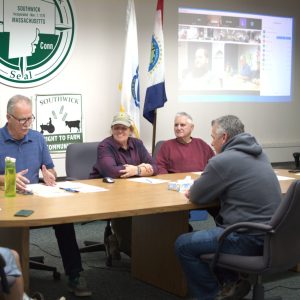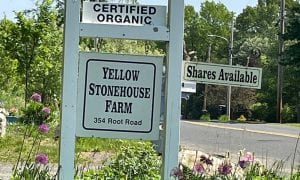This is the time of year when homeowners all across America throw down the gauntlet challenging Mother Nature to produce a picture-perfect rolling carpet of lush green lawn. We spend our precious weekends applying pesticides and chemicals while the frustration grows, to say nothing of the gobs of money we spend to achieve this unsustainable goal. The truth is that pesticides and poisons are non-selective and will kill many beneficial living things that come in contact with them, including pets and wildlife.
Historically, organic lawn care has been practiced for much longer than chemical lawn care and it can easily be implemented on any lawn. Safe and effective alternatives exist for most chemical pesticides and fertilizers. Here are some reasons not to fight with your lawn, and eco-friendly alternatives to make your life healthier and less stressful while saving you money, time and energy.
Chemical pesticides and fertilizers contaminate surface and groundwater.
Lawn pesticides and fertilizers can contaminate surface and groundwater. These chemicals diminish the quality of drinking water as well as the quality of wetlands. If you have well water you should re-think use of these products. Many fish and aquatic insects are highly sensitive to fertilizers and pesticides. If you live next to a stream or pond, fertilizers can cause excessive plant growth in the water, harming both the environment and aesthetics. If you notice a pond with excessive plant growth, it may be the result of overuse of pesticides and fertilizers.
Chemical pesticides threaten the health of children.
Children are the most vulnerable segment of our population due to their small size and their underdeveloped physiology. They are often more exposed to pesticides due to their behavior (playing in the grass or breathing close to the ground). As a child I attended a 4th of July picnic at my grandparents’ house. I had to be rushed to the hospital when I woke up in the middle of the night with difficulty breathing and a full-body allergic reaction. We later figured out it was due to a chemical mixture that had been applied to the lawn prior to the family picnic.
Chemical pesticides threaten the health of outdoor pets.
Outdoor pets are highly exposed to lawn chemicals due to their behavior (licking contaminated paws and coat, breathing close to the ground, eating contaminated grass, soil and toys) and are highly vulnerable due to their small size. Pets can be fatally poisoned from lawn chemicals, ask your veterinarian for further advice.
Chemical pesticides threaten the health of local wildlife.
Turf dwelling and feeding species such as robins, rabbits, cardinals, snakes, raccoons and squirrels are highly exposed to lawn chemicals. In addition, granular formulation pesticides can severely impact birds that mistake the granules for seed or if it gets into streams and water which they drink from. You may even consider naturalizing a section of your yard to provide a greater diversity of shelter and food types. The more diverse nature is, the more stable and self-sustaining it is, and the less it needs fertilizers to enhance growth.
Chemical pesticides and fertilizers kill beneficial organisms.
Healthy soil is alive with a variety of beneficial organisms that actually kill pest insects, decrease the spread of disease and help plants gather nutrients and water. For example, earthworms improve air and water circulation, decompose thatch, deposit nutrient-rich castings and help to neutralize soil (plants prefer this pH). Many beneficial organisms like earthworms are highly exposed and sensitive to lawn chemicals. Pesticide and fertilizer use reduces a lawn’s natural ability to control pests and diseases, gather nutrients and water and maintain overall health. Lack of these beneficial organisms only prompts the need for more fertilizers to feed your lawn.
Ideally, the best strategy would be to identify and remove only the pest, causing minimal disruption to the system. Unfortunately, current pesticides are non-selective and kill non-targeted and beneficial organisms. However, within the last few years many new and exciting products have emerged or have greatly improved in effectiveness. Some of the more commonly used and effective pesticides are Insect (Mite) Growth Regulators (IGR’s), Bacillus thuringiensis (B.t.), horticultural oils, insecticidal soaps, entomopathogenic nematodes, and NEEM. I suggest you consult a local nursery to help you decide which is best for your particular pest problem.
Chemical fertilizers are a waste of money. Compost instead!
Your lawn is an ecosystem. A biologically diverse and healthy ecosystem will not need fertilizers or poisons to “help” it. Chemical fertilizers usually contain three macronutrients – phosphorus, potassium and nitrogen. They lack other macro as well as micronutrients and include no organic matter or microbes. In contrast, compost is an organic and natural soil amendment that provides a more complete package of nutrients, organic matter and microbes. Kitchen scraps (anything except dairy or meat waste) can create a nutrient rich compost soil. Compost is a free resource that also constitutes sustainable waste management, extending the lifespan of local dumps and landfills. In addition, you can easily make a “compost tea” to water your plants. Compost tea is easily made by soaking or steeping compost in water. This makes a potion that both fertilizes and prevents disease. Great for potted plants!
Chemicals actually degrade the over-all long-term health of your lawn and garden.
By frequently applying pesticides to your lawn, you can create a chemical-dependent landscape. Pest species become resistant to the chemicals designed to kill them and beneficial species die thereby requiring more concentrated doses and more frequent applications. This creates a never-ending cycle of increasing pest resistance and pesticide use.
Accept other plant species in your lawn.
Remember your lawn is an ecosystem. Fighting that ecosystem to get a lawn of only one plant species requires constant attention to maintain. Nature likes diversity and ecosystems with higher diversity are more stable and need less attention. So it’s healthier to have various plant species in your lawn, particularly clover. One of the elements added to fertilizers is nitrogen which is the most important element for plant development. Too much nitrogen causes plants to grow uncontrollably which we see in algal blooms or weed-choked ponds. Not enough nitrogen inhibits plant growth. Clover “fixes” or provides a usable form of nitrogen for other plants, therefore the presence of clover helps to feed your lawn.
Set your lawn mower blades higher.
Cutting your grass too low stresses out the grass, requiring more frequent watering and fertilizing and makes it more susceptible to pests and diseases. It is recommended that you remove no more than 1/3 of the leaf blade at one cutting. If you see brown grass or dirt patches after you mow set the blades higher next time. Another good strategy is mow when the grass is dry and alternate mowing patterns to avoid compaction and ruts.
Between identifying your lawn’s specific needs and using a few different techniques, you can reduce time, costs and your family’s exposure to chemicals while at the same time creating a more self-sustaining lawn.
Karen E. Leigh is the Conservation Coordinator for the City of Westfield.







